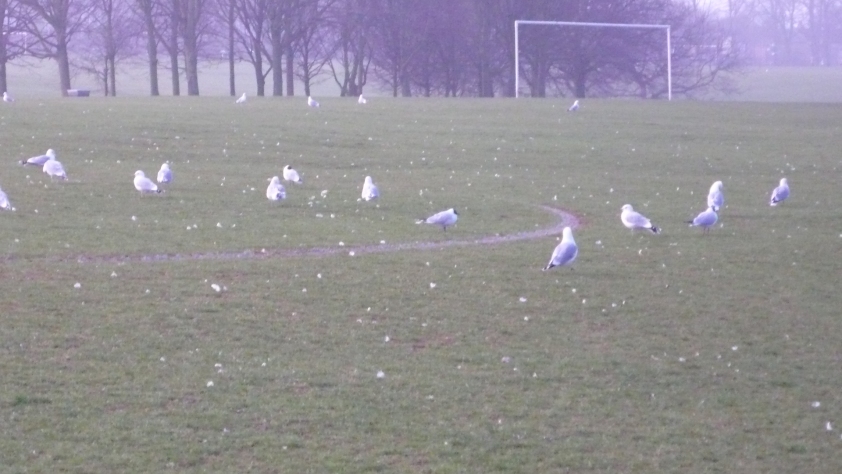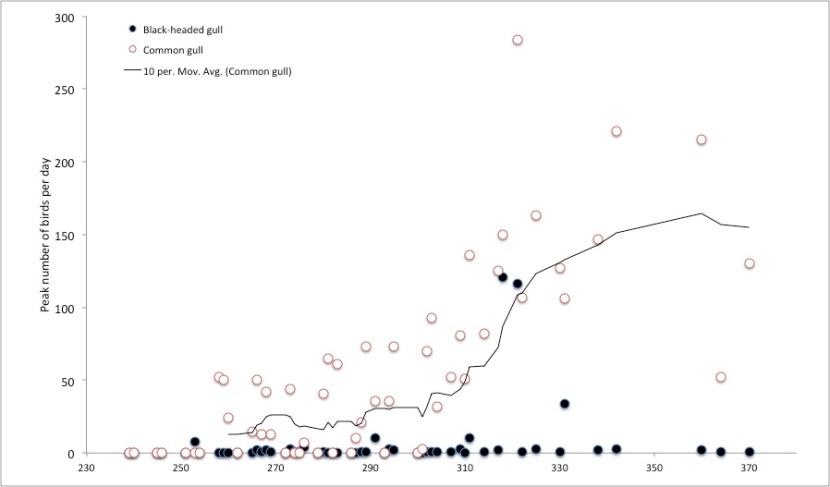For the second in my occasional series of “data I’ll never publish” I want to present a short post about how two species of gulls use an urban Northampton park in the winter. The park is called the Racecourse (I’ve mentioned it before) and is en route to the campus on which I work. It’s long been apparent that the numbers of gulls using the park increases from autumn into winter and declines to zero in the spring and summer, when they head off to breed in and around Northamptonshire’s reservoirs and gravel pits, and further afield. During the winter they spend their time feeding on earthworms, squabbling, chasing crows, and generally relaxing prior to the next breeding season.
What I was interested in knowing was just how quickly the numbers built up, whether it was a slow, steady build-up or a rapid influx of birds, and also the relative numbers of the two commonest species to be found there, Black-headed gull (Chroicocephalus ridibundus) and Common gull (Larus canus).
So during my walks to work between late August 2014 and early January 2015 I simply counted the numbers of birds I saw in the quadrant of the park that I passed. Certainly not the most onerous data collection I’ve ever carried out, and done purely because it interested me, not with any view to conducting a serious study. Here’s the data plotted up as peak birds seen per day, with day of the year on the x-axis, running from 27th August to 5th January:
A few things intrigue me about this. First of all, Common gulls are much more, er, “common”, on the park than Black-headed gulls, despite the fact that Black-headed gulls are far more abundant in the UK during the winter (estimated as 2.2 million versus 710,000 birds). However anecdotally I’ve observed that other parks in Northampton appear to have more Black-headed gulls, suggesting that the two species are to some extent dividing up the urban parks and other grasslands between themselves, like rival gangs with different local patches.
That’s purely speculative and would be worth pursuing as a student project, to test if (a) this hypothesis is correct; and (b) whether that division of the parks is stable between years.
The other thing that’s of interest from these data is that, as you can see from the 10-day moving average, the Common gulls suddenly increase in numbers around the middle of November. I wonder whether this is due to an influx of migrant birds coming in from further north and east in Europe and Scandinavia? At the same time I recorded an unusually large flock of Black-headed gulls: were these also migrants just passing through?
Urban gulls have been getting some bad press recently; but they really are fascinating birds that add a lot to the biodiversity interest of our parks and playing fields. They deserve further study because we take them for granted and there’s really not much published on their urban ecology.



Interesting, good one Jeff. So much to learn from common situations if we just pay attention. I watch the gulls a lot on Lake Erie shore but not very systematically.
Thanks Jim, I agree, it’s the common species that we often fail to look at carefully.
Pingback: Gull use of urban parks in winter – data I’ll never publish (2) | An Urban Web of Life
Pingback: Polinode – a user-friendly tool for visualising ecological networks | Jeff Ollerton's Biodiversity Blog